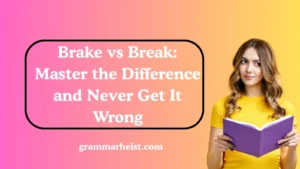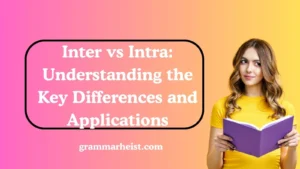When you’re sharing information with others, it’s important to find the right words to make your message clear, helpful, and considerate. While “Just a heads up” is common, there are many alternatives you can use to ensure your communication is engaging and appropriate for the context. Whether you’re sending a friendly reminder, providing a warning, or offering useful advice, choosing the right phrase can add warmth and clarity to your message.
Is It Professional/Polite to Say “Just a Heads Up”?
It’s essential to understand the context in which you’re using phrases like “Just a heads up.” While it’s casual and friendly, there are some situations where it may feel too informal or lack the necessary formality. For instance, in highly professional or formal settings, you may want to opt for more polished alternatives to communicate effectively.
Pros and Cons of Saying “Just a Heads Up”
Pros:
- Casual and approachable: It feels less stiff and more conversational.
- Clear: It delivers information directly and concisely.
- Friendly tone: Makes the recipient feel at ease without overwhelming them.
Cons:
- Too informal for formal settings: It may not always be suitable for professional or serious environments.
- Can sound vague: The phrase itself doesn’t always convey the urgency or importance of the message.
- Overused: It might lack originality and become monotonous if used too often.
Synonyms For “Just a Heads Up”:
- I Wanted to Let You Know
- Just So You Know
- I Thought I’d Mention
- Just to Keep You in the Loop
- I Wanted to Give You a Quick Update
- Just a Quick FYI
- Wanted to Give You a Heads Up
- Just a Reminder
- I Wanted to Bring This to Your Attention
- Just Wanted to Give You a Heads Up on This
- Just Thought I’d Mention
- Wanted to Make Sure You Were Aware
- Just a Quick Note
- Wanted to Alert You
- Just Giving You a Quick Update
- Just a Quick Heads-Up
- Just Wanted to Mention
- Just Giving You a Quick FYI
- I Just Wanted to Give You a Quick Reminder
- Just Thought You Should Know
- Just a Quick Tip
- I Just Want to Bring This to Your Attention
- Just Want to Make Sure You’re Aware
- I Thought I’d Give You a Quick Heads-Up
- Just a Little Heads-Up
- I Wanted to Alert You
- Just to Give You a Little Nudge
- Just a Friendly Reminder
- Thought I’d Give You a Quick Heads-Up
- I Wanted to Make You Aware
1. I Wanted to Let You Know
Scenario: When you want to share important information without sounding abrupt.
Examples:
- “I wanted to let you know that the meeting time has been changed.”
- “I wanted to let you know we’re running a bit behind on the project.”
- “I wanted to let you know about some upcoming changes to the schedule.”
Tone: Friendly, informative, and professional.
Explanation: This phrase adds a personal touch while keeping your message clear and polite.
2. Just So You Know
Scenario: When providing important but non-urgent information.
Examples:
- “Just so you know, I’ll be out of the office this afternoon.”
- “Just so you know, the deadline has been extended.”
- “Just so you know, there’s a slight change in the plan.”
Tone: Casual, informative, and considerate.
Explanation: This phrase is more informal, making it ideal for casual conversations and giving gentle reminders.
3. I Thought I’d Mention
Scenario: When offering a quick, friendly reminder or piece of information.
Examples:
- “I thought I’d mention that the project deadline has been moved.”
- “I thought I’d mention that we need to confirm the meeting location.”
- “I thought I’d mention there’s a slight delay in the schedule.”
Tone: Casual, thoughtful, and friendly.
Explanation: This phrase feels less formal and works well in more laid-back conversations.
4. Just to Keep You in the Loop
Scenario: When you want to ensure someone stays updated on an ongoing situation.
Examples:
- “Just to keep you in the loop, we’ve made a few changes to the plan.”
- “Just to keep you in the loop, the client’s feedback is expected later today.”
- “Just to keep you in the loop, we’re awaiting approval before proceeding.”
Tone: Informative, inclusive, and clear.
Explanation: This phrase makes the recipient feel included in the process, ideal for team or project-related updates.
5. I Wanted to Give You a Quick Update
Scenario: When you’re providing a brief but necessary update.
Examples:
- “I wanted to give you a quick update on the progress of the project.”
- “I wanted to give you a quick update—our meeting is now at 3 PM.”
- “I wanted to give you a quick update on the client’s request.”
Tone: Polite, professional, and considerate.
Explanation: This phrase is excellent when you’re delivering important information without sounding too casual.
6. Just a Quick FYI
Scenario: When offering a brief, non-urgent piece of information.
Examples:
- “Just a quick FYI, we’re starting the meeting 10 minutes later.”
- “Just a quick FYI, the office will be closed for a holiday next week.”
- “Just a quick FYI, the team is still working on the final draft.”
Tone: Casual, concise, and to the point.
Explanation: This is great for informal settings where brevity is valued, and the information isn’t critical.
7. Wanted to Give You a Heads Up
Scenario: When you want to inform someone of an upcoming situation or potential change.
Examples:
- “I wanted to give you a heads up about the delay in delivery.”
- “I wanted to give you a heads up that I’ll be on vacation next week.”
- “I wanted to give you a heads up that the meeting has been rescheduled.”
Tone: Professional, direct, and considerate.
Explanation: This phrase signals a future change or event, allowing the recipient to prepare.
8. Just a Reminder
Scenario: When you want to gently remind someone about an upcoming task or deadline.
Examples:
- “Just a reminder that the presentation is due tomorrow.”
- “Just a reminder that the meeting starts at 10 AM sharp.”
- “Just a reminder to send in your feedback by Friday.”
Tone: Polite, helpful, and courteous.
Explanation: A polite alternative that doesn’t feel too abrupt, great for maintaining professionalism while nudging someone.
9. I Wanted to Bring This to Your Attention
Scenario: When you need to highlight something that requires awareness or action.
Examples:
- “I wanted to bring this to your attention: we’re behind on the project timeline.”
- “I wanted to bring this to your attention before the meeting.”
- “I wanted to bring this to your attention—there’s an important email you may have missed.”
Tone: Professional, respectful, and direct.
Explanation: This phrase is ideal for more formal settings, when you need to draw someone’s attention to a key matter.
10. Just Wanted to Give You a Heads Up on This
Scenario: When you want to warn someone about something important that may require action.
Examples:
- “Just wanted to give you a heads up on this—there’s a change in the timeline.”
- “Just wanted to give you a heads up on this—we may need extra resources for the task.”
- “Just wanted to give you a heads up on this: the client has some last-minute requests.”
Tone: Friendly, proactive, and informative.
Explanation: This phrase gives the same vibe as “just a heads up,” but feels slightly more personal and direct.
11. Just Thought I’d Mention
Scenario: When you want to casually drop a note about something important.
Examples:
- “Just thought I’d mention the office is closed for the long weekend.”
- “Just thought I’d mention that we may need to reschedule the meeting.”
- “Just thought I’d mention the team is awaiting your feedback.”
Tone: Casual, conversational, and considerate.
Explanation: This phrase gives a laid-back yet thoughtful tone to your communication.
12. Wanted to Make Sure You Were Aware
Scenario: When ensuring someone is well-informed about a situation.
Examples:
- “Wanted to make sure you were aware of the new updates to the project.”
- “Wanted to make sure you were aware that the deadline is fast approaching.”
- “Wanted to make sure you were aware of the changes in the meeting schedule.”
Tone: Professional, thorough, and polite.
Explanation: A more formal option that works well when you need to ensure the person is fully informed.
13. Just a Quick Note
Scenario: When offering quick information in a friendly tone.
Examples:
- “Just a quick note: I’ve updated the document with your changes.”
- “Just a quick note: the system will be down for maintenance tomorrow.”
- “Just a quick note to let you know the meeting time has shifted.”
Tone: Light, friendly, and casual.
Explanation: This phrase is an excellent quick and lighthearted way to provide a gentle reminder.
14. Wanted to Alert You
Scenario: When you need to bring someone’s attention to a possible issue or situation.
Examples:
- “Wanted to alert you that the event has been postponed.”
- “Wanted to alert you about a change in the company policy.”
- “Wanted to alert you that there’s been a slight delay in the delivery.”
Tone: Alert, professional, and focused.
Explanation: This alternative is more direct and works well when you need to address a potential problem or change.
15. Just Giving You a Quick Update
Scenario: When you want to share recent news or changes.
Examples:
- “Just giving you a quick update—everything is on track for the project.”
- “Just giving you a quick update: the presentation is scheduled for next week.”
- “Just giving you a quick update that the meeting is moved to 2 PM.”
Tone: Polite, concise, and clear.
Explanation: Great for quick, informative updates that don’t require much elaboration.
16. Just a Quick Heads-Up
Scenario: When giving someone a brief warning or notice.
Examples:
- “Just a quick heads-up, there might be some delays with the shipment.”
- “Just a quick heads-up, we need your approval before proceeding.”
- “Just a quick heads-up, the office will be closed for a few days next week.”
Tone: Friendly, alert, and casual.
Explanation: Similar to “just a heads-up,” this version sounds a bit more casual and adds a sense of urgency.
17. Just Wanted to Mention
Scenario: When casually giving a brief, non-urgent update or reminder.
Examples:
- “Just wanted to mention that the team is waiting for your confirmation.”
- “Just wanted to mention that we’re expecting some rain tomorrow.”
- “Just wanted to mention the meeting is still on for 3 PM.”
Tone: Casual, informal, and friendly.
Explanation: This is a laid-back phrase that’s perfect for informal communication where the stakes are low.
18. Just Giving You a Quick FYI
Scenario: When sharing a small piece of important information without an immediate need for action.
Examples:
- “Just giving you a quick FYI, I’ve sent over the revised proposal.”
- “Just giving you a quick FYI, the event starts at 6 PM instead of 5.”
- “Just giving you a quick FYI that the meeting will be recorded.”
Tone: Casual, quick, and informative.
Explanation: Ideal for informal settings, where you want to pass along information quickly.
19. I Just Wanted to Give You a Quick Reminder
Scenario: When you want to send a reminder about something important.
Examples:
- “I just wanted to give you a quick reminder about the team meeting tomorrow.”
- “I just wanted to give you a quick reminder to review the document before the meeting.”
- “I just wanted to give you a quick reminder about the upcoming deadline.”
Tone: Helpful, polite, and clear.
Explanation: This is a simple way to remind someone politely without being too forward or demanding.
20. Just Thought You Should Know
Scenario: When you want to inform someone about something that might affect them.
Examples:
- “Just thought you should know, the office will be closed tomorrow.”
- “Just thought you should know that the client has approved the proposal.”
- “Just thought you should know that we’ve rescheduled the meeting.”
Tone: Informative, considerate, and thoughtful.
Explanation: This phrase gives a sense of care while providing important details.
21. Just a Quick Tip
Scenario: When giving someone a helpful piece of advice or notice.
Examples:
- “Just a quick tip: don’t forget to back up your files before the system update.”
- “Just a quick tip—make sure to double-check the presentation for typos.”
- “Just a quick tip: it might be worth checking in with the team before the meeting.”
Tone: Friendly, helpful, and insightful.
Explanation: Ideal for providing useful advice in a casual way, while keeping the tone light and approachable.
22. I Just Want to Bring This to Your Attention
Scenario: When you need to notify someone about something important.
Examples:
- “I just want to bring this to your attention—there’s an issue with the budget.”
- “I just want to bring this to your attention, the event has been rescheduled.”
- “I just want to bring this to your attention—the report is due tomorrow.”
Tone: Direct, respectful, and professional.
Explanation: A bit more formal, ideal for bringing attention to important matters that may require action.
23. Just Want to Make Sure You’re Aware
Scenario: When ensuring someone is informed about an upcoming change or event.
Examples:
- “Just want to make sure you’re aware the meeting has been moved to Thursday.”
- “Just want to make sure you’re aware that there’s a new policy in place.”
- “Just want to make sure you’re aware of the new software update.”
Tone: Clear, professional, and thorough.
Explanation: This phrase emphasizes ensuring awareness, making it suitable for more formal environments.
24. I Thought I’d Give You a Quick Heads-Up
Scenario: When you want to casually inform someone about something.
Examples:
- “I thought I’d give you a quick heads-up—the conference call has been delayed.”
- “I thought I’d give you a quick heads-up that the client wants to meet earlier.”
- “I thought I’d give you a quick heads-up—we may need to work late tonight.”
Tone: Casual, friendly, and considerate.
Explanation: This feels informal and approachable, ideal for providing quick notices without sounding too formal.
25. Just a Little Heads-Up
Scenario: When you want to add a bit more warmth or softness to your message.
Examples:
- “Just a little heads-up that the office will be closed this Friday.”
- “Just a little heads-up—there might be some traffic on your way to the event.”
- “Just a little heads-up that we’ve extended the deadline by a few days.”
Tone: Friendly, gentle, and considerate.
Explanation: This version softens the message and works well in casual conversations.
26. I Wanted to Alert You
Scenario: When you need to warn someone or bring their attention to something that may cause concern.
Examples:
- “I wanted to alert you about a potential delay in the project.”
- “I wanted to alert you that the package was not delivered on time.”
- “I wanted to alert you that we need to address some issues with the client.”
Tone: Urgent, professional, and clear.
Explanation: Best used in formal contexts where immediate attention may be required.
27. Just to Give You a Little Nudge
Scenario: When you want to gently remind someone of something they may have forgotten.
Examples:
- “Just to give you a little nudge, don’t forget to submit your timesheet.”
- “Just to give you a little nudge, please confirm your attendance at the meeting.”
- “Just to give you a little nudge, we need your feedback on the proposal soon.”
Tone: Friendly, casual, and lighthearted.
Explanation: This phrase feels playful yet helpful, great for reminding someone in a non-forceful way.
28. Just a Friendly Reminder
Scenario: When offering a helpful, non-urgent reminder.
Examples:
- “Just a friendly reminder to send me your report by 3 PM.”
- “Just a friendly reminder to update your availability for the next week.”
- “Just a friendly reminder that the team lunch is tomorrow!”
Tone: Warm, considerate, and helpful.
Explanation: Great for casual work environments or situations where you want to keep things light and polite.
29. Thought I’d Give You a Quick Heads-Up
Scenario: When you want to casually provide some helpful or necessary information.
Examples:
- “Thought I’d give you a quick heads-up—the office will be closed Monday.”
- “Thought I’d give you a quick heads-up about the upcoming deadline.”
- “Thought I’d give you a quick heads-up, there’s a change in the schedule.”
Tone: Informal, direct, and helpful.
Explanation: Works well for informal conversations, making sure the recipient gets a quick and easy update.
30. I Wanted to Make You Aware
Scenario: When you need to inform someone of something important or time-sensitive.
Examples:
- “I wanted to make you aware that the meeting has been moved to Friday.”
- “I wanted to make you aware of the changes to the event logistics.”
- “I wanted to make you aware of the software update tomorrow.”
Tone: Professional, clear, and polite.
Explanation: This is a formal and respectful way to inform someone of any important changes or events.
Conclusion
These 30 alternatives to “just a heads up” offer variety and flexibility in communication. Whether you’re giving a quick reminder, sharing an update, or providing important information, the right phrase can make all the difference in ensuring your message is clear, considerate, and effective.

Emma Rose is a dedicated writing expert with a passion for helping others enhance their communication skills. With a strong background in grammar, language structure, and style, Emma empowers individuals to write with clarity, confidence, and impact. Her approach combines a keen attention to detail with a supportive, personalized touch, ensuring each person she works with improves and grows in their writing journey.













